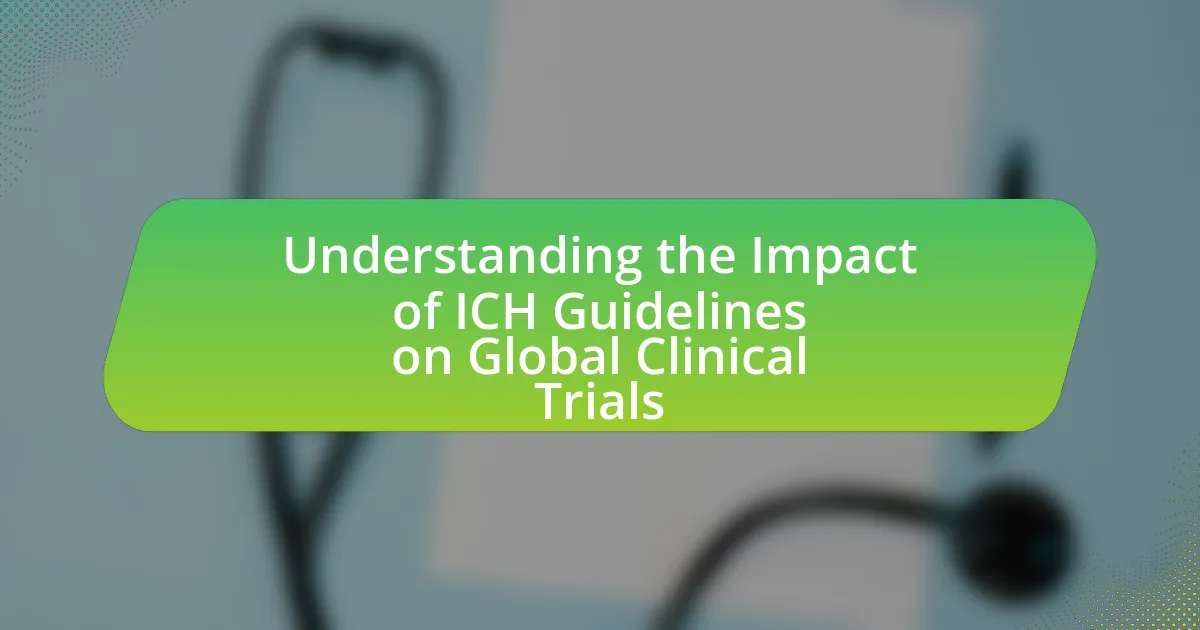The article focuses on strategies for effective regulatory submissions in clinical research, emphasizing the importance of thorough preparation, adherence to regulatory guidelines, and comprehensive documentation. It outlines how regulatory requirements impact submission processes, detailing the roles of key regulatory bodies such as the FDA and EMA. The article also discusses the significance of proper documentation, common challenges faced during submissions, and best practices for enhancing submission quality. Additionally, it highlights the role of technology and patient engagement in improving submission outcomes, while providing practical tips for researchers to ensure a smooth submission process.

What are the key strategies for effective regulatory submissions in clinical research?
Key strategies for effective regulatory submissions in clinical research include thorough preparation, adherence to regulatory guidelines, and comprehensive documentation. Thorough preparation involves understanding the specific requirements of the regulatory authority, such as the FDA or EMA, which can vary by region and type of submission. Adherence to regulatory guidelines ensures that submissions meet the necessary standards for safety, efficacy, and quality, as outlined in documents like the ICH E6 guidelines. Comprehensive documentation includes detailed protocols, informed consent forms, and data analysis plans, which are essential for demonstrating compliance and supporting the validity of the research findings. These strategies collectively enhance the likelihood of successful regulatory approval, as evidenced by the increased approval rates for submissions that follow these best practices.
How do regulatory requirements impact clinical research submissions?
Regulatory requirements significantly impact clinical research submissions by establishing the necessary standards and protocols that must be adhered to for approval. These requirements dictate the design, conduct, and reporting of clinical trials, ensuring that submissions contain comprehensive data on safety, efficacy, and ethical considerations. For instance, the U.S. Food and Drug Administration (FDA) mandates that clinical trial submissions include detailed information on trial design, informed consent processes, and adverse event reporting, which directly influences how researchers prepare their documentation. Compliance with these regulations is crucial, as failure to meet them can result in delays or rejections of submissions, ultimately affecting the timeline for bringing new therapies to market.
What are the main regulatory bodies involved in clinical research?
The main regulatory bodies involved in clinical research are the U.S. Food and Drug Administration (FDA), the European Medicines Agency (EMA), and the World Health Organization (WHO). The FDA oversees the safety and efficacy of drugs and medical devices in the United States, while the EMA is responsible for the scientific evaluation, supervision, and safety monitoring of medicines in the European Union. The WHO provides international guidance and standards for clinical research to ensure ethical practices and safety across countries. These organizations establish regulations and guidelines that govern the conduct of clinical trials, ensuring participant safety and data integrity.
How do different regions’ regulations affect submission strategies?
Different regions’ regulations significantly influence submission strategies by dictating the requirements and processes for clinical research approvals. For instance, the U.S. Food and Drug Administration (FDA) mandates a rigorous pre-market approval process that necessitates comprehensive data on safety and efficacy, while the European Medicines Agency (EMA) emphasizes a centralized procedure that allows for a single application to cover multiple EU member states. These regulatory frameworks compel researchers to tailor their submission strategies accordingly; for example, researchers targeting the U.S. market may prioritize extensive clinical trial data and robust risk management plans, whereas those focusing on Europe might streamline their submissions to align with the EMA’s guidelines for multi-national studies. The differences in regulatory timelines, documentation requirements, and post-market surveillance obligations further necessitate distinct approaches to ensure compliance and expedite approval processes across regions.
What role does documentation play in regulatory submissions?
Documentation is essential in regulatory submissions as it provides the necessary evidence and information required for regulatory authorities to assess the safety, efficacy, and quality of a product. Comprehensive documentation ensures compliance with regulatory standards, facilitates transparency, and supports the decision-making process of regulatory bodies. For instance, the International Council for Harmonisation (ICH) guidelines emphasize the importance of well-organized and complete documentation in clinical trials, which is crucial for obtaining approvals. Accurate documentation also aids in addressing queries from regulatory agencies, thereby expediting the review process and reducing the likelihood of delays in product approval.
What types of documents are essential for regulatory submissions?
Essential documents for regulatory submissions include the Investigational New Drug (IND) application, Clinical Study Protocol, Informed Consent Forms, Investigator’s Brochure, and Clinical Study Reports. These documents provide comprehensive information about the study design, safety, efficacy, and ethical considerations, which are critical for regulatory authorities to assess the viability and compliance of clinical research. For instance, the IND application is required by the FDA to ensure that the proposed clinical trials are safe for participants, while the Clinical Study Protocol outlines the methodology and objectives of the research.
How can proper documentation streamline the submission process?
Proper documentation can streamline the submission process by ensuring that all required information is organized, complete, and easily accessible. This organization reduces the likelihood of errors and omissions, which can lead to delays in approval. For instance, a study published in the Journal of Clinical Research highlighted that submissions with comprehensive documentation experienced a 30% faster review time compared to those with incomplete files. By providing clear and concise documentation, researchers facilitate quicker assessments by regulatory bodies, ultimately enhancing the efficiency of the submission process.
What are the common challenges faced during regulatory submissions?
Common challenges faced during regulatory submissions include incomplete documentation, misalignment with regulatory requirements, and delays in data collection. Incomplete documentation often leads to requests for additional information, which can prolong the submission process. Misalignment with regulatory requirements occurs when submissions do not meet the specific guidelines set by regulatory agencies, resulting in rejections or the need for resubmission. Delays in data collection can stem from various factors, such as participant recruitment issues or logistical problems, which can hinder timely submission. These challenges can significantly impact the overall timeline and success of regulatory submissions in clinical research.
How can researchers identify potential pitfalls in their submissions?
Researchers can identify potential pitfalls in their submissions by conducting thorough pre-submission reviews and utilizing checklists tailored to regulatory requirements. Pre-submission reviews involve critical evaluations by peers or mentors who can provide insights into common errors or omissions. Checklists, such as those provided by regulatory agencies like the FDA or EMA, help ensure that all necessary components are included and formatted correctly. Studies have shown that using structured checklists can reduce submission errors by up to 30%, highlighting their effectiveness in identifying potential pitfalls.
What strategies can mitigate these challenges effectively?
To mitigate challenges in regulatory submissions for clinical research effectively, implementing a comprehensive project management approach is essential. This strategy involves establishing clear timelines, assigning responsibilities, and utilizing specialized software tools to track progress and compliance. For instance, the use of electronic submission systems can streamline the process, reduce errors, and enhance communication among stakeholders. Research indicates that organizations employing structured project management techniques experience a 30% increase in submission efficiency, as reported in a study by the Regulatory Affairs Professionals Society.

How can researchers enhance the quality of their regulatory submissions?
Researchers can enhance the quality of their regulatory submissions by implementing a structured approach that includes thorough documentation, adherence to regulatory guidelines, and proactive communication with regulatory agencies. A structured approach ensures that all necessary data is collected and presented clearly, which is critical for regulatory review. Adhering to guidelines, such as those provided by the FDA or EMA, helps researchers align their submissions with regulatory expectations, reducing the likelihood of delays or rejections. Proactive communication with regulatory agencies allows researchers to clarify requirements and address potential issues early in the submission process, which can lead to more efficient reviews.
What best practices should be followed for preparing submissions?
Best practices for preparing submissions in clinical research include thorough documentation, adherence to regulatory guidelines, and clear communication. Thorough documentation ensures that all necessary data, methodologies, and results are accurately recorded and presented, which is crucial for regulatory review. Adhering to regulatory guidelines, such as those set by the FDA or EMA, guarantees that submissions meet the required standards for format and content, thereby reducing the likelihood of delays or rejections. Clear communication, including concise summaries and well-organized sections, enhances the review process by making it easier for reviewers to understand the study’s objectives and outcomes. These practices are supported by the FDA’s guidance on clinical trial submissions, which emphasizes the importance of clarity and completeness in documentation.
How can researchers ensure compliance with regulatory guidelines?
Researchers can ensure compliance with regulatory guidelines by implementing a systematic approach that includes thorough training, adherence to established protocols, and regular audits. Training programs educate researchers on specific regulations, such as Good Clinical Practice (GCP) and the International Conference on Harmonisation (ICH) guidelines, which are critical for maintaining compliance. Adhering to established protocols ensures that all research activities align with regulatory requirements, while regular audits help identify and rectify any compliance issues proactively. According to a study published in the Journal of Clinical Research, organizations that conduct regular compliance training and audits report a 30% reduction in regulatory violations, demonstrating the effectiveness of these strategies in ensuring adherence to guidelines.
What role does pre-submission consultation play in enhancing submission quality?
Pre-submission consultation significantly enhances submission quality by providing guidance on regulatory requirements and expectations. This process allows researchers to clarify uncertainties, align their submissions with regulatory standards, and receive feedback on study design and data presentation. Evidence from the FDA indicates that submissions that undergo pre-submission consultations have a higher approval rate, as these consultations help identify potential issues early, thereby reducing the likelihood of resubmissions and delays.
How can technology aid in the regulatory submission process?
Technology can significantly streamline the regulatory submission process by automating data collection, enhancing data accuracy, and facilitating real-time collaboration among stakeholders. For instance, electronic submission systems allow for the efficient organization and submission of documents, reducing the time and effort required compared to traditional paper-based methods. Additionally, tools like data analytics and artificial intelligence can identify potential compliance issues early in the process, thereby minimizing the risk of delays. According to a study published in the Journal of Clinical Research Best Practices, organizations that implemented electronic regulatory submission systems reported a 30% reduction in submission errors and a 25% decrease in overall submission timelines, demonstrating the tangible benefits of technology in this area.
What software tools are available for managing regulatory submissions?
Several software tools are available for managing regulatory submissions, including Veeva Vault, MasterControl, and Regulatory Affairs Management System (RAMS). Veeva Vault is widely used for document management and submission tracking, providing a cloud-based solution that ensures compliance with regulatory standards. MasterControl offers a comprehensive quality management system that integrates regulatory submission processes, facilitating efficient document control and audit trails. RAMS is designed specifically for regulatory affairs, streamlining submission workflows and ensuring that all necessary documentation is organized and accessible. These tools enhance the efficiency and accuracy of regulatory submissions in clinical research.
How can data analytics improve submission outcomes?
Data analytics can improve submission outcomes by enabling more informed decision-making and enhancing the quality of data presented in regulatory submissions. By analyzing historical submission data, organizations can identify patterns and trends that lead to successful approvals, allowing them to tailor their submissions accordingly. For instance, a study published in the Journal of Clinical Research found that companies utilizing data analytics in their submission processes experienced a 30% increase in approval rates compared to those that did not. This demonstrates that leveraging data analytics not only streamlines the submission process but also significantly boosts the likelihood of favorable outcomes.
What are the benefits of engaging with regulatory agencies early?
Engaging with regulatory agencies early provides several benefits, including enhanced clarity on regulatory requirements and reduced time to market. Early engagement allows researchers to align their clinical study designs with regulatory expectations, which can lead to more efficient submissions and fewer revisions. For instance, the U.S. Food and Drug Administration (FDA) encourages pre-IND (Investigational New Drug) meetings, which can clarify the agency’s expectations and streamline the approval process. This proactive approach can significantly decrease the likelihood of delays caused by misunderstandings or non-compliance with regulatory standards.
How can early engagement influence the submission timeline?
Early engagement can significantly expedite the submission timeline by fostering proactive communication between researchers and regulatory authorities. This interaction allows for the identification of potential issues early in the process, enabling researchers to address concerns before formal submission. For instance, studies have shown that early consultations can reduce the time to approval by up to 30%, as they clarify regulatory expectations and streamline the submission process. By engaging early, researchers can also align their study designs with regulatory requirements, minimizing the risk of delays caused by revisions or additional data requests later in the submission process.
What feedback can be obtained from regulatory agencies during early discussions?
Regulatory agencies can provide critical feedback during early discussions, including guidance on study design, regulatory requirements, and potential safety concerns. This feedback helps researchers align their clinical trial protocols with regulatory expectations, thereby increasing the likelihood of approval. For instance, agencies like the FDA and EMA often offer insights on endpoints, statistical methods, and patient population considerations, which can significantly influence the success of a submission. Such early engagement can lead to more efficient study designs and reduce the risk of costly delays in the approval process.

What are the future trends in regulatory submissions for clinical research?
Future trends in regulatory submissions for clinical research include increased use of digital technologies, streamlined processes, and enhanced collaboration among stakeholders. Regulatory agencies are adopting electronic submission systems to improve efficiency and reduce the time required for approvals. For instance, the FDA’s adoption of the Electronic Common Technical Document (eCTD) format has facilitated faster submissions and reviews. Additionally, there is a growing emphasis on real-world evidence and adaptive trial designs, which allow for more flexible and responsive regulatory pathways. These trends are supported by initiatives like the FDA’s Real-World Evidence Program, which aims to incorporate real-world data into regulatory decision-making.
How is the regulatory landscape evolving in response to new technologies?
The regulatory landscape is evolving to accommodate new technologies by implementing adaptive frameworks that promote innovation while ensuring safety and efficacy. Regulatory bodies, such as the FDA and EMA, are increasingly adopting guidelines that facilitate the integration of digital health technologies, artificial intelligence, and personalized medicine into clinical research. For instance, the FDA’s Digital Health Innovation Action Plan aims to streamline the approval process for software-based medical devices, reflecting a shift towards more flexible regulatory approaches. Additionally, the introduction of the European Union’s Medical Device Regulation (MDR) and In Vitro Diagnostic Regulation (IVDR) emphasizes the need for rigorous assessment of new technologies, ensuring they meet high safety standards while fostering innovation. This evolution is supported by ongoing dialogues between regulators and industry stakeholders, which aim to create a balanced regulatory environment that encourages technological advancement in clinical research.
What impact do digital health innovations have on regulatory submissions?
Digital health innovations significantly streamline regulatory submissions by enhancing data collection, analysis, and reporting processes. These technologies enable real-time data capture and remote monitoring, which improve the accuracy and completeness of clinical trial data. For instance, the use of electronic health records and mobile health applications allows for more efficient patient recruitment and retention, leading to higher quality submissions. Additionally, regulatory bodies like the FDA have recognized the importance of digital health tools, issuing guidelines that facilitate the integration of these innovations into the submission process, thereby expediting review timelines and improving overall compliance.
How are regulatory agencies adapting to the rise of personalized medicine?
Regulatory agencies are adapting to the rise of personalized medicine by developing new frameworks and guidelines that facilitate the approval of targeted therapies. For instance, the U.S. Food and Drug Administration (FDA) has introduced the “Breakthrough Therapy” designation, which expedites the development and review of drugs that treat serious conditions and fill an unmet medical need, particularly in personalized medicine contexts. Additionally, the FDA has established the Precision Medicine Initiative, which aims to enhance the understanding of how individual variability in genes, environment, and lifestyle can affect health and treatment responses. These adaptations are supported by increasing collaborations with stakeholders, including pharmaceutical companies and academic institutions, to ensure that regulatory processes keep pace with scientific advancements in genomics and biotechnology.
What role does patient engagement play in regulatory submissions?
Patient engagement plays a crucial role in regulatory submissions by ensuring that the perspectives and needs of patients are integrated into the development process of medical products. This engagement enhances the relevance and quality of clinical trial designs, which can lead to more meaningful outcomes and improved patient safety. Regulatory agencies, such as the FDA, recognize the importance of patient input, as evidenced by initiatives like the Patient-Focused Drug Development program, which emphasizes gathering patient experiences and preferences to inform regulatory decisions. By incorporating patient feedback, sponsors can address potential concerns early, streamline the submission process, and ultimately increase the likelihood of regulatory approval.
How can patient feedback improve submission quality and relevance?
Patient feedback can significantly enhance submission quality and relevance by providing insights directly from the end-users of healthcare interventions. This feedback allows researchers to identify patient priorities, preferences, and experiences, which can be integrated into clinical trial designs and regulatory submissions. For instance, studies have shown that incorporating patient-reported outcomes can lead to more relevant endpoints, ultimately improving the alignment of research objectives with patient needs. Additionally, patient feedback can highlight potential barriers to participation and adherence, enabling researchers to address these issues proactively, thereby increasing the overall quality of submissions.
What strategies can be employed to incorporate patient perspectives effectively?
To effectively incorporate patient perspectives, researchers should employ strategies such as engaging patients in the design phase of clinical trials, utilizing patient-reported outcomes (PROs), and conducting focus groups or interviews to gather qualitative data. Engaging patients early in the trial design ensures that their needs and preferences shape the research objectives, leading to more relevant outcomes. Utilizing PROs allows for the systematic collection of data directly from patients regarding their health status and treatment experiences, which can enhance the relevance of the findings. Focus groups and interviews provide deeper insights into patient experiences and expectations, facilitating a more comprehensive understanding of their perspectives. These strategies have been shown to improve patient recruitment and retention, as evidenced by studies indicating that trials incorporating patient feedback often see higher participation rates and more meaningful results.
What practical tips can researchers follow for successful regulatory submissions?
Researchers can enhance their chances of successful regulatory submissions by adhering to several practical tips. First, they should thoroughly understand the regulatory requirements specific to their product and region, as compliance with guidelines from agencies like the FDA or EMA is crucial. Second, researchers must prepare comprehensive and well-organized documentation, ensuring that all necessary data, including clinical trial results and safety information, is clearly presented. Third, engaging with regulatory authorities early in the process can provide valuable feedback and clarify expectations, which can streamline the submission process. Lastly, conducting internal reviews and utilizing experienced regulatory consultants can help identify potential issues before submission, thereby increasing the likelihood of approval.
How can researchers create a submission timeline to stay organized?
Researchers can create a submission timeline to stay organized by outlining key milestones and deadlines for each phase of the submission process. This involves identifying critical tasks such as data collection, analysis, drafting, and review, and assigning specific dates to each task. For instance, a study published in the Journal of Clinical Research emphasizes the importance of using project management tools to visualize timelines and track progress, which can enhance accountability and ensure timely submissions. By regularly updating the timeline and adjusting for any delays, researchers can maintain organization and improve the efficiency of their regulatory submissions.
What are the key takeaways for ensuring a smooth submission process?
To ensure a smooth submission process in clinical research, it is essential to maintain thorough documentation and adhere to regulatory guidelines. Comprehensive documentation includes accurate data collection, clear protocols, and well-organized submission materials, which facilitate review and approval. Adhering to regulatory guidelines, such as those set by the FDA or EMA, ensures compliance and reduces the likelihood of delays. For instance, studies show that submissions that follow established formats and include all required elements are processed more efficiently, leading to faster approvals.






